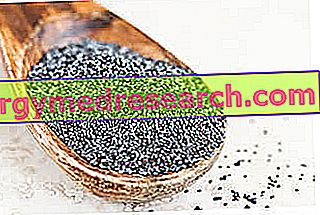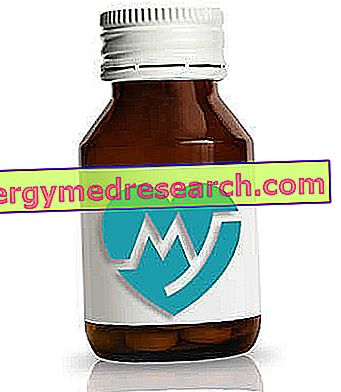The "Papavero" is a herbaceous plant typical of the Mediterranean basin and areas with a temperate / sub tropical climate. According to the variety, the poppy plants are between 30 and 100 cm high and some of them are famous for the production of a latex rich in narcotic alkaloids;

Poppies useful for the production of food seeds (to toast or for oily production) are instead to be considered "harmless" varieties.
Poppies for oil
The poppy seeds used for the production of oil belong to two botanical varieties:
- Papaver nigrum, also called Mediterranean poppy or black-seeded poppy (originally from Turkey and structurally very similar to white opium poppy)
- Papaver setigerum, also called silk or oil poppy (spontaneous in almost all the Mediterranean basin and also in Italy); botanists think that many other poppy varieties, such as Papaver somniferum and the aforementioned Papaver nigrum, derive from this species .
Nutritional Properties
Today, the use of poppy seed oil has a marginal role in food; it is used in Central and Eastern Europe only for confectionery production, while extraction and retail are exclusively of a craft nature. Poppy seed oil has a very pleasant nutty flavor and from an organoleptic point of view it is much more prized than peanut oil or other seeds; it boasts the same chemical characteristics of linseed oil or sweet almond oil (due to its polyunsaturated fatty acid content) although (entering "nutritional detail") the ω3 / ω6 ratio is different.
Although it can be considered an "obsolete" food, poppy seed oil has a very ancient history ...
The first to use poppy seed oil in a relevant way were the Gallic peoples (or better, the Celts, the Aquitans and the Belgians); they occupied: France, Belgium, Switzerland (in which, among the various archaeological finds, seeds of Papaver setigerum were found), the Netherlands, Germany (along the western bank of the Rhine) and northern Italy (north of the river Esino), where it settled from the 8th century BC to 400-500 AD; Gallic poppy cultivation for oil production was mainly located in Germany, Flanders and throughout central Europe.
In Paris, in the 16th century, poppy seed oil was still consumed as it was less expensive than olive oil and above all less prone to rancidity (probably due to lower concentrations of water, since [contrary to what can be inferred] the amount of polyunsaturated fatty acids is far greater than poppy seed oil).
From the eighteenth century onwards, perhaps confusing the papaver nigrum with the papaver somniferum, the rumor spread that oilseed could be harmful to health; consequently (despite the denials of the medical community) its consumption was almost totally abandoned; its sale was abolished by the French parliament, an order then revoked (as for that of rape and rape oil) only in 1774 thanks to the in-depth analysis of Abbot Rozier.
Poppy oil is a good seasoning fat, but based on some medical and nutritional (though dated), it is also very useful:
- In the treatment of intestinal constipation
- In the remission of scrofulous affections [chronic infections of the lymphatic glands due to Mycobacterium tuberculosis ( tuberculosis bacterium), which in the advanced stage causes bad-smelling abscesses in the neck, armpits and groin, disfiguring those affected
- In the remission of rickets
- As an emollient in bladder diseases
- For topical use: in tampons, in remission of ulceration and inflammation of the skin; coated for cleaning and hydration of the same.
Nutritional values
Poppy seed oil is 99.9% lipid and contains only a few traces of water.
Macronutrients for 100g of poppy seed oil
| Energy (kcal) | 884 | ||
| Energy nutrients | |||
| Lipids (g) | 99.9 | ||
| Saturated (g) | 13.5 | ||
| Monounsaturated (g) | 19.7 | ||
| Polyunsaturated (g) | 62.4 | ||
| 18: 2 undifferentiated (g) | 61.8 | ||
| 18: 3 undifferentiated (g) | 0.6 | ||
| Phytosterols (mg) | 276 | ||
| Vitamins | |||
| α-tocopherol (mg) | 11.4 | ||
Poppy seed oil is rich in polyunsaturated fatty acids, especially undifferentiated 18: 2, ie an Essential Fatty Acid (AGE) of the ω6 family; these are highly oxidizable lipids that can guarantee a "minimum" shelf life ONLY in the presence of antioxidant tocopherols (vit. E), present in poppy seed oil in quantities slightly less than those of extra virgin olive oil. There is also a fair concentration of phytosterols which, in association with the aforementioned ω6, can be useful in diet therapy against hypercholesterolemia.
Bibliography:
- Planetary herbal medicine. Healing properties and plant symbolism - F. Alaimo - Hermes editions - pag. 50-51
- Encyclopedia of Health Plants - G. Debuigne - Gremese publisher - pag. 172



